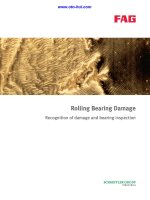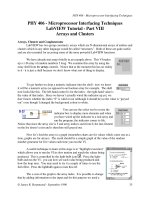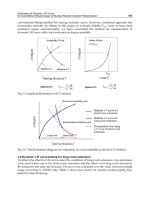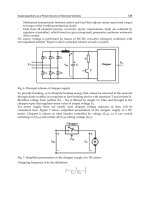Rolling Bearing Damage 2009 Part 8 docx
Bạn đang xem bản rút gọn của tài liệu. Xem và tải ngay bản đầy đủ của tài liệu tại đây (265.34 KB, 7 trang )
3.4 Assessment of lip contact
Fig. 78 illustrates a well run-in lip
surface.
3.4.1 Damage to lip and roller faces
in roller bearings
3.4.1.1 Scoring due to foreign particles
Symptoms:
Arc-shaped scratches in the lip surface
or roller face (particularly frequent with
tapered roller bearings), figs. 79 and 80.
Their depth into the lip area depends on
the rolling element radius the foreign
particle became stuck in.
Causes:
Hard foreign particles in lubricant
which are drawn into the area of contact
between roller face and lip.
Remedial measures:
Improve lubricant cleanliness.
FAG 48
Evaluation of running features and damage to dismounted bearings
Lip contact
80: Scoring on the face of a tapered
roller
79: Lip area scoring due to foreign
particles
78: Normal run-in lip contact track in a
tapered roller bearing
3.4.1.2 Seizure in lip contact
Symptoms:
Partial or large-area welding and deep
scratches in the lip and roller face areas,
figs. 81 and 82. Also lubricant coking in
this area. Frequently related to very high
loads.
Causes:
– Inadequate lubrication with high
loads and high speeds (quantity or
operating viscosity of lubricant too
low)
– Inadequate lubrication with high
loads and low speeds when there is no
hydrodynamic lubricating film be-
tween roller face and lip
– Too high preload of tapered roller
bearings
– Detrimental preload due to heat ex-
pansion
– Skewing of rollers for example in the
case of raceway wear, ring tilting or
insufficient adjustment, fig. 81
– Axial load too high on cylindrical
roller bearings
– Axial preload of inner ring too high
for out-of-square mating surfaces.
Remedial measures:
– Improve lubrication (increase vis-
cosity, EP additives, increase lubricant
quantity)
– Ensure correct adjustment of bearings
49 FAG
Evaluation of running features and damage to dismounted bearings
Lip contact
81: Skewing rollers caused seizure marks at the lip when in contact with its edges.
82: Seizure can arise at the roller face and lip when the lubricant supply is
inadequate and loads are high.
3.4.1.3 Wear in the lip contact area
Symptoms:
In the case of roller bearings poor
lubrication conditions are first revealed
by the sliding contact roller face/lip. In
serious cases the previously mentioned
seizure phenomena result. In all cases,
however, the contact areas have wear
characteristics. This can be clearly seen
in the cross profile chart of the lip or roller
faces, fig. 83. Rims frequently develop at
the roller faces also. In the case of tapered
roller bearings a reduction in preload or
extended axial clearance results. This
leads, for example in transmissions with
load direction inversion, to increased
running noise. The amount of wear in
the lip contact area enters only about
1/3 of the axial clearance in the case of
tapered roller bearings due to the geo-
metric conditions. Lip wear is also an in-
dication for wear in the raceway or roller
outside diameter.
Causes:
– Inadequate lubrication (type, quanti-
ty)
– Contaminated lubricant
Remedial measures:
– Ensure utmost cleanliness
– Choose suitable lubricant (viscosity,
EP additives) and ensure sufficient
supply
FAG 50
Evaluation of running features and damage to dismounted bearings
Lip contact
83: Cross profile chart of a worn
tapered roller face
84: Rim formation at the tapered roller
3.4.1.4 Lip fractures
Symptoms:
Supporting lips are completely or
partly broken off or cracked, fig. 85.
Causes:
– Axial load unacceptably high
– Lip insufficiently supported, fig. 20
– Axial shock load
– Subsequent damage of cage and
rolling element fracture
– Mounting damage
Remedial measures:
– Ensure good lip support design
– Keep load within the limits assumed
for designing
– Observe mounting specifications
51 FAG
Evaluation of running features and damage to dismounted bearings
Lip contact
85: Lip broken off a barrel roller bearing. The inner ring was driven onto the shaft
with a hammer.
3.4.2 Wear of cage guiding surfaces
Symptoms:
Wear may result when cages – parti-
cularly brass cages – are guided at the
lips of bearing rings. The surface is
usually badly roughened and seizure also
results (cage material clings to lip). A
shoulder develops at the lip when there
is a lot of wear since the cage is not as a
rule in contact with its entire width,
fig. 86. Similar wear characteristics are
also found at the side edges of the corre-
sponding cage, see section 3.5.1. It is
particularly hazardous for the inner ring
lip contact of high-speed bearings.
Causes:
– Insufficient lubricant supply to
contact areas, often inadequate
drainage of the lubricant
– Contaminated lubricant
– Speed too high for the bearings
applied
– Excess tilting during assembly
– Unexpectedly high operating temper-
ature in the case of outer ring guided
brass cages (different heat expansion
steel/brass)
Remedial measures:
– Improve lubrication (greater flow,
more cleanliness)
– Use bearings designed for operating
conditions in question
– Coat cage
FAG 52
Evaluation of running features and damage to dismounted bearings
Lip contact
86: Bad contact marks on the cage guiding surface of an outer ring lip with
smeared on material
3.4.3 Damage to seal running areas
3.4.3.1 Worn sealing lip tracks
Symptoms:
At the area of the sealing lip contact a
circumferential groove, usually shiny,
develops in the lip. Also in conjunction
frequently with worn sealing lips and
damage to the bearing as a result of
penetrating contaminants. Corrosion in
the sealing area is found in several cases
as well, fig. 87.
Causes:
– Extreme amount of external dirt, par-
ticularly in moist environment.
– Lip runs dry.
Remedial measures:
– Use preseals, e.g. flinger rings.
– Lubricate sealing lip.
3.4.3.2 Discolouration of sealing track
Symptoms:
Brown or blue colour in the area of
sealing lip contact, particularly in the
case of shaft seals. Excess heating leads to
hardening and intense wear of the seal-
ing, see section 3.6.1.
Causes:
– Intense heating of lip and shaft area
due to overlapping or to a high press-
on force of the sealing
– Sealing lip area of contact not suffi-
ciently lubricated
Remedial measures:
– Lubricate sealing lip
– Reduce press-on force insofar as per-
missible for the sealing effect
53 FAG
Evaluation of running features and damage to dismounted bearings
Lip contact
87: Corrosion in the area of the sealing track at the lip of an angular contact ball
bearing
3.5 Cage damage
3.5.1 Wear due to starved lubrication
and contamination
Symptoms:
In the case of cages with lip guidance
wear in the side edges, for those guided
by rolling elements wear in the pockets.
Subsequent damage due to advanced
wear could cause rolling element guid-
ance to develop into lip guidance and
abrade there also or vice versa. Wear is
generally in the axial direction to a large
extent symmetric in the pockets or in the
case of cylindrical roller bearings at both
side edges, fig. 88.
Causes:
– Lubricant contaminated with hard
foreign particles
– Too little or unsuitable lubricant
Remedial measures:
– Ensure clean assembly conditions
– Filter lubricant
– Increase lubricant flow through
and/or apply a different viscosity
FAG 54
Evaluation of running features and damage to dismounted bearings
Cage damage
88: Wear of cage side edges
3.5.2 Wear due to excess speed
Symptoms:
Wear of cage outside diameter due to
grazing at the bearing outer ring, fig. 89.
Causes:
– Excess speed
– Unsuitable cage construction selected
Remedial measures:
– Use different type of cage
89: Wear of cage outside diameter due
to grazing at the bearing outer ring









